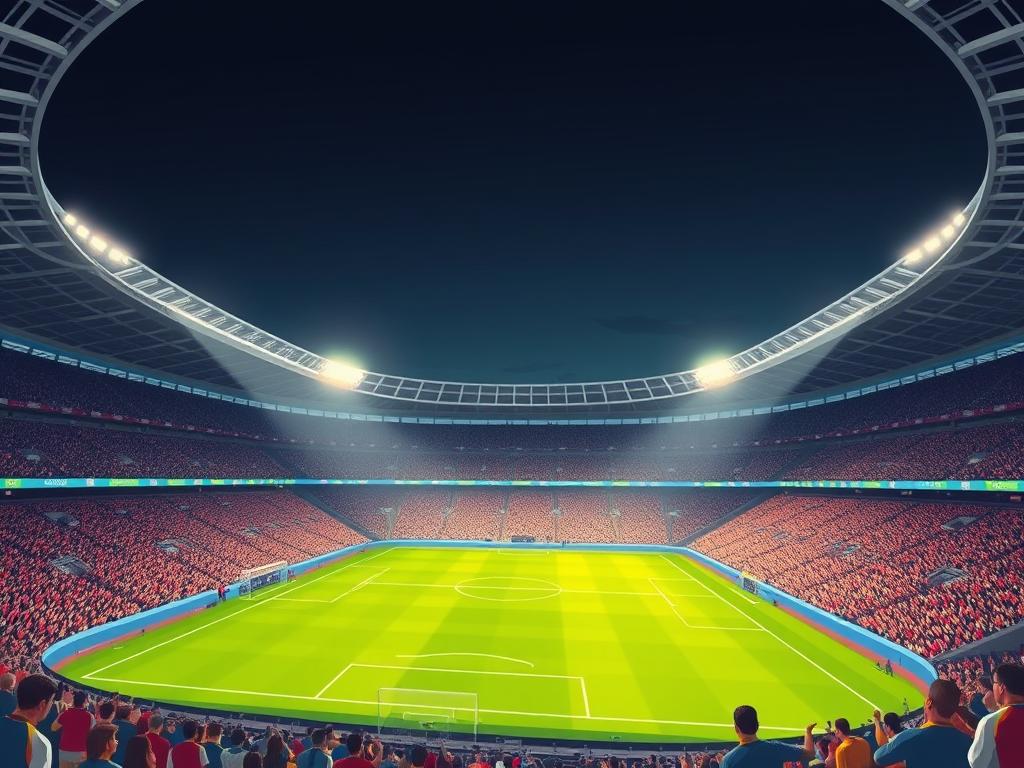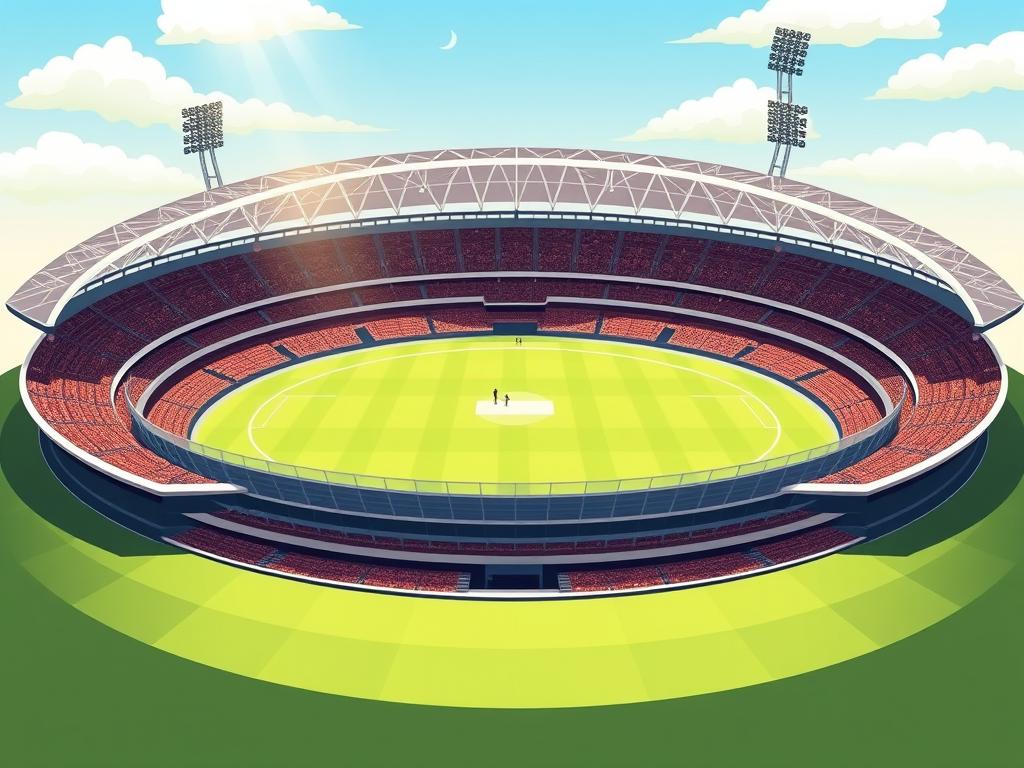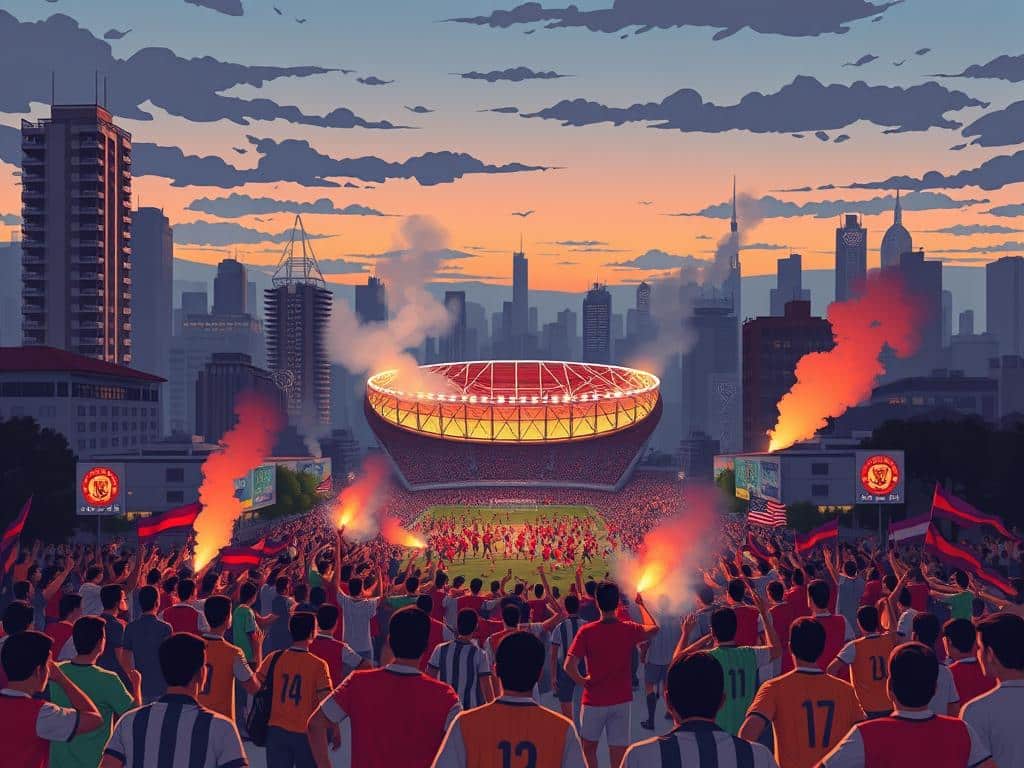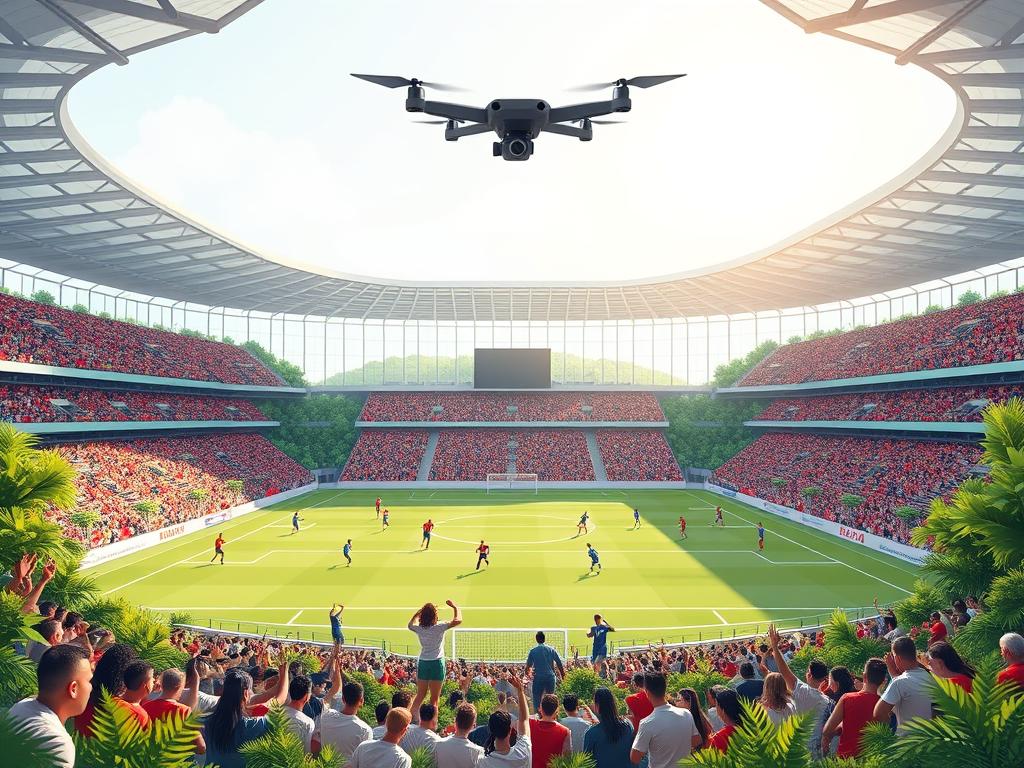I love how a packed arena can change the game for both teams and fans. The list of these iconic venues spans Camp Nou, Rungrado 1st of May, FNB, Wembley, and other famous homes that carry history and thunderous applause.
What matters most isn’t just the number of seats. It’s the real match-day setup — safe seating, acoustics, and how a venue shapes the crowd’s roar. I’ll show you current figures and explain when official numbers differ from what you actually see on game night.
Expect clear comparisons and practical notes you can use when planning travel or just arguing with friends about which arena feels biggest. This snapshot focuses on verified seating and the features that make each stadium special at home and on the world stage.
Key Takeaways
- Official seat counts can differ from match-day setups; I explain why.
- Some venues are historic icons beyond their seating numbers.
- Stadium features—roof, bowl, layout—shape the fan experience.
- I focus on verified, current figures rather than inflated claims.
- This list helps you compare venues quickly and plan visits with confidence.
What “largest” means today: capacities, usage, and why it matters
Not every reported number tells the true story of how many people can watch a match safely. I use practical figures that reflect current football layouts and safety rules.
Official totals can differ from usable seating. For example, Estadio Azteca lists ~87,523 but is trimmed to about 83,000 for 2026 standards. The Rose Bowl shows 95,542 officially, yet soccer setups often sit nearer 90,000 due to codes.
Renovations matter. Camp Nou is closed now and aims for roughly 105,000 when work finishes. Egypt’s New Administrative Capital Stadium sits near 93,940 and already serves as the national stadium, shifting the country’s hierarchy.
- “Largest” here means seats you can realistically sell for football today, not past highs or other-sport layouts.
- Primary use matters: a national stadium hosting regular matches ranks differently than a multi-sport venue used occasionally.
- I favor current soccer configurations and flag caveats so you can compare venues with confidence.
Global heavyweights that pack the stands
A few giant venues keep reappearing in conversations about epic match nights. I’ll run through notable homes around the world and give you a quick fact for each. These highlights help you compare at a glance.
Rungrado 1st of May Stadium, Pyongyang
Reported at 150,000, modern estimates drop it to about 114,000. Built in 1989, its magnolia-like roof makes it instantly recognizable.
Melbourne Cricket Ground, Melbourne
Seats 100,024. A multi-sport icon, the Melbourne Cricket Ground still stages major football friendlies and qualifiers after big upgrades in 1992 and 2006.
Camp Nou, Barcelona
Listed at 99,354 today and under renovation toward ~105,000. When it reopens, this will be Europe’s biggest football home.
FNB Stadium, Johannesburg
Holds 94,736. It hosted the 2010 World Cup final and remains South Africa’s national stadium and a home for big clubs and teams.
New Administrative Capital Stadium, Egypt
About 93,940 seats. The Nefertiti-inspired design marks a modern national stadium built for major events.
Wembley Stadium, London
Officially 90,000 with an iconic arch. Wembley Stadium hosts England’s national team and top finals around the world.
Estadio Azteca, Mexico City
Official ~87,523, temporarily reduced near ~83,000 for 2026 upgrades. It hosted two World Cup finals and still holds historical record attendances.
Bukit Jalil National Stadium, Kuala Lumpur
87,411 seats. The Bukit Jalil national bowl is the biggest in Southeast Asia and home to Malaysia’s national team.
Borg El-Arab Stadium, Alexandria
About 86,000. Built for Egypt’s 2010 World Cup bid, the Borg El-Arab stadium now hosts national team matches and major club nights.
Rose Bowl, Pasadena
Officially 95,542 but soccer setups often sit near ~90,000. It hosted the 1994 World Cup final and holds a long record of record events.
Quick contrast: some venues list higher official numbers, while match-day setups and renovations often change the usable totals. That matters when you plan travel or compare records.
| Venue | Reported / Current | Notable use | Highlight |
|---|---|---|---|
| Rungrado 1st of May | 150,000 / ~114,000 | National events | Magnolia-like roof; built 1989 |
| Melbourne Cricket Ground | 100,024 | Multi-sport (football tests) | Major upgrades 1992, 2006 |
| Camp Nou | 99,354 / ~105,000 (post-renovation) | Club home (Barcelona) | Europe’s largest football home once reopened |
| FNB Stadium | 94,736 | National team & clubs | 2010 World Cup final venue |
Largest soccer stadiums by capacity: quick-reference list
Here’s a compact checklist to compare the world’s top venues at a glance. I kept figures current and added short caveats for renovations and event layouts.

Rungrado 1st of May Stadium (North Korea) — modern estimate ~114,000. Built for mass events and athletics; some lists include it for football though primary use varies.
Camp Nou (Barcelona) — 99,354 today, targeting ~105,000 after work. Barcelona’s home remains a top reference for high-end football seating.
FNB Stadium (Johannesburg) — 94,736. Hosted a World Cup final and stays South Africa’s flagship for major matches.
New Administrative Capital Stadium (Egypt) — about 93,940. Egypt’s new national home built for large-scale football events.
Rose Bowl (United States) — official 95,542; soccer setups often sit near ~90,000. Hosted a FIFA World final and big record crowds.
Wembley Stadium (London) — 90,000. England’s primary venue for finals and national team fixtures.
Estadio Azteca (Mexico City) — ~87,523 official, temporarily reduced near ~83,000 for 2026 prep. Only venue with two men’s World Cup finals on record.
Bukit Jalil National (Kuala Lumpur) — 87,411 seats; Southeast Asia’s largest national bowl.
Borg El-Arab Stadium (Alexandria) — ~86,000; built during a FIFA bid and now a steady national-team stage.
| Venue | Current figure | Note |
|---|---|---|
| Rungrado 1st of May | ~114,000 | Mass events; football inclusion varies |
| Camp Nou | 99,354 / ~105,000 | Under renovation; post-work target |
| Rose Bowl | 95,542 / ~90,000 | Soccer layouts reduce seats |
| Estadio Azteca | ~87,523 / ~83,000 | Temporary reduction for 2026 |
Tip: use this list to compare venues quickly. Always check current event layouts and renovation notes before planning travel or citing records.
North America spotlight: venues U.S. fans know
From historic bowls to chrome-and-glass arenas, U.S. venues offer three distinct flavors of the big-game night. I’ll run through each place with practical facts you can use when planning a trip or choosing tickets.
Rose Bowl’s soccer legacy and record crowds
The Rose Bowl lists an official 95,542 but soccer layouts often sit nearer ~90,000 due to safety rules and sightline changes. It hosted eight games in the 1994 World Cup and the tournament’s cup final — moments that cemented its cross-sport reputation.
The bowl stays busy with high-profile friendlies and club tours. When top teams visit, ticket demand and atmosphere spike fast.
MetLife Stadium’s $1.7B stage and the 2026 FIFA World Cup final
MetLife cost about $1.7 billion to build and serves as home to the Giants and Jets. It’s also selected to host the 2026 World Cup final — a clear signal of its event pedigree and transit-ready infrastructure.
Expect polished production, strong sightlines, and big-event logistics that match global matches.
Michigan Stadium context: colossal scale with occasional showcases
Michigan Stadium seats 107,601 and is primarily a college football icon. When soccer comes to Ann Arbor, organizers can deliver huge crowds and a rare, electric atmosphere that feels almost festival-like.
- Quick practical tips: Check event-specific seating layouts — numbers can drop for soccer setups.
- For once-in-a-generation matches, MetLife in 2026 is the must-see U.S. event.
- Choose Rose Bowl for tradition and Michigan for sheer scale when tickets appear.
| Venue | Notable fact | Typical use |
|---|---|---|
| Rose Bowl | 1994 World Cup cup final; ~90,000 for soccer | Friendlies; big-name tours |
| MetLife Stadium | $1.7B build; 2026 World Cup final host | NFL home; global events |
| Michigan Stadium | 107,601 seats; massive match nights | College football; occasional showcases |
How World Cups shape stadium status
Hosting a World Cup final can rewrite a venue’s place in football history overnight. A single tournament brings upgrades, new flows, and a global spotlight that lasts long after the trophy leaves town.
Lusail Stadium and the 2022 final’s global stage
Lusail hosted the 2022 final and instantly became a design and delivery benchmark. The event proved how a new build can set standards for hospitality, media, and pitch tech during a world cup final.
Estadio Azteca’s rare World Cup history and 2026 readiness
Estadio Azteca holds a unique record with two men’s World Cup finals. For 2026, it is undergoing temporary reductions to meet fifa world standards while keeping its aura and famous moments intact.
Wembley’s finals pedigree and modern hosting power
Wembley stays in front by hosting cup finals, playoff deciders, and international fixtures. That steady calendar keeps it fresh in the conversation whenever a world cup or big tournament approaches.
FNB Stadium’s 2010 finale and continuing national-team role
FNB’s 2010 final validated major renovations and improved acoustics. Today it remains a go-to for the national team and for major continental events, proving legacy pays off.
- Technical upgrades: World Cups force better hospitality, media centres, accessibility, and safety—often reshaping seating and flow.
- Long-term gains: Hosts secure more elite events, stronger revenue streams, and an elevated fan experience.
- Comparative lens: Even venues like Rungrado 1st May (1st May Stadium) in North Korea are measured against world cup-tested operations when capacity claims surface.
| Venue | Notable world cup role | Legacy effect |
|---|---|---|
| Lusail Stadium | 2022 final host | Global benchmark for modern event delivery |
| Estadio Azteca | 1970 & 1986 finals; 2026 updates | Historic record and modern compliance upgrades |
| Wembley | Regular finals & major matches | Consistent top-tier event calendar |
| FNB Stadium | 2010 World Cup final | Renovation-validated national hub |
“Largest soccer stadiums by capacity” versus multi-purpose giants
When lists argue over who tops the charts, the split often comes down to how a venue is used, not just its headline numbers.
Why some mega-venues qualify and others don’t
Why primary use matters
Lists vary because their rules vary. Some count multi-purpose colossi that host major matches. Others include only football stadiums with a soccer-primary tenant.
That difference explains why Sporting News and others exclude Rungrado, the big U.S. college bowls, and the Melbourne Cricket Ground from football-primary rankings.

MCG, Rose Bowl, and the football-specific debate
The Melbourne Cricket Ground and the Rose Bowl host huge international fixtures, but they are not soccer-primary. Michigan Stadium is occasional for the sport as well.
Practical points for U.S. fans and travelers:
- If you want raw turnout, multi-purpose venues—often built for american football or as a cricket ground—deliver sheer scale.
- If you want the pure match-day sightlines and club-oriented amenities, choose a football-specific home.
- Be transparent: good lists state whether a site is a football-first venue or a shared arena.
| Venue type | Typical strength | Example |
|---|---|---|
| Football-primary | Better sightlines; club focus | Club and national homes |
| Multi-purpose | Huge turnout; flexible event use | american football bowls / cricket ground setups |
| Occasional host | Festival feel; one-off records | Rose Bowl, Michigan Stadium, melbourne cricket ground |
The key is honesty about usage. When you read lists, check the rules. That way you can pick the right match-night—record-setting scale or a true football atmosphere.
Capacities evolve: renovations, safety codes, and new builds
Renovations and rules reshape how many fans a ground can host on any given match day. I track what changes and why it matters for you, whether you’re planning a trip or cheering from the home stand.
Camp Nou’s expansion toward ~105,000
Camp Nou targets roughly 105,000 seats after work. The plan adds modern concourses, tech, and better sightlines so big match days feel smoother and louder without bottlenecks.
Estadio Azteca’s temporary reduction for 2026
Estadio Azteca is trimmed to about ~83,000 to meet FIFA World standards for 2026. This temporary step widens circulation, boosts hospitality, and improves safety—trading raw numbers for a safer event flow.
Egypt’s New Administrative Capital Stadium as a national centerpiece
The New Administrative Capital Stadium (~93,940) was built as a modern national stadium. Its Nefertiti-inspired design and smart systems mean repeat hosting is easier and fan comfort is a priority.
- Bukit Jalil national keeps adding retractable features to stay flexible across events while keeping the football feel.
- South Africa’s FNB shows how a 2010 upgrade—roof, suites, lighting—can lift an older ground into a modern home for major matches.
- Remember: fewer seats on paper often equals better legroom, visibility, and safety for fans on game day.
| Venue | Current change | Why it matters | Benefit for fans |
|---|---|---|---|
| Camp Nou | Expansion to ~105,000 | Modern concourses; tech upgrades | Better sightlines; faster ingress |
| Estadio Azteca | Temporary ~83,000 | FIFA world compliance for 2026 | Safer circulation; improved hospitality |
| New Administrative Capital | ~93,940 built new | Modern national stadium design | Reliable hosting; comfort |
| Bukit Jalil National | Retractable elements added | Flexible event layouts | Versatile match-day experience |
How to read capacity numbers with confidence
Start with the date. Numbers change fast during renovations and tournament prep. A list from several years ago can miss temporary reductions or post-work increases.
Check the use-case. Is the figure an official total or a match-day setup? The Rose Bowl, for example, lists a higher official count but often sells fewer seats for football matches due to sightlines and safety.
Watch for safety notes. Modern all-seater rules and evacuation standards trimmed many historic records from standing-terrace eras like Maracanã and Hampden. Those old records are great trivia, not apples-to-apples comparisons.
- Look for “temporary reduction” flags—Estadio Azteca’s lower number for 2026 is one such note.
- Ask whether the ground is football-primary or multi-purpose; use affects how seats are laid out.
- See if counts include hospitality, media, or standing areas that aren’t used in normal matches.
| Check | Why it matters | Action |
|---|---|---|
| Publication date | Shows if number is current | Prefer recent stadium operator or organizer updates |
| Match vs. official | May differ by game setup | Verify “for football” or “for tournament” wording |
| Historic records | Often from standing terraces | Don’t compare old standing records with today’s seated totals |
Final tip: trust lists that publish rules. When a list explains its criteria, you can judge which venue truly suits your idea of scale and which numbers are just records on paper.
Conclusion
The clearest measure of a venue is how it hosts teams, fans, and major events today.
Judge a ground on current football use, not old records. Renovations like Camp Nou’s work, Azteca’s temporary changes for 2026, and Egypt’s new national home shift the map fast.
Key takeaways: prefer match-day numbers, note whether a site is a club or multi-purpose home, and watch how world tournaments raise standards.
Keep this list handy and revisit it as projects finish. If you want a practical primer on match-day feel and design, read our MLS stadium experience.





